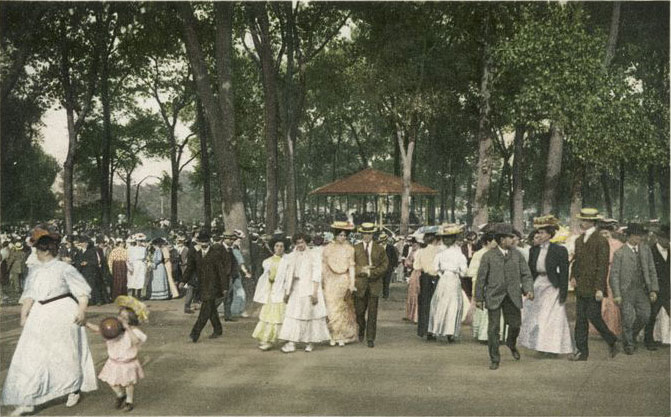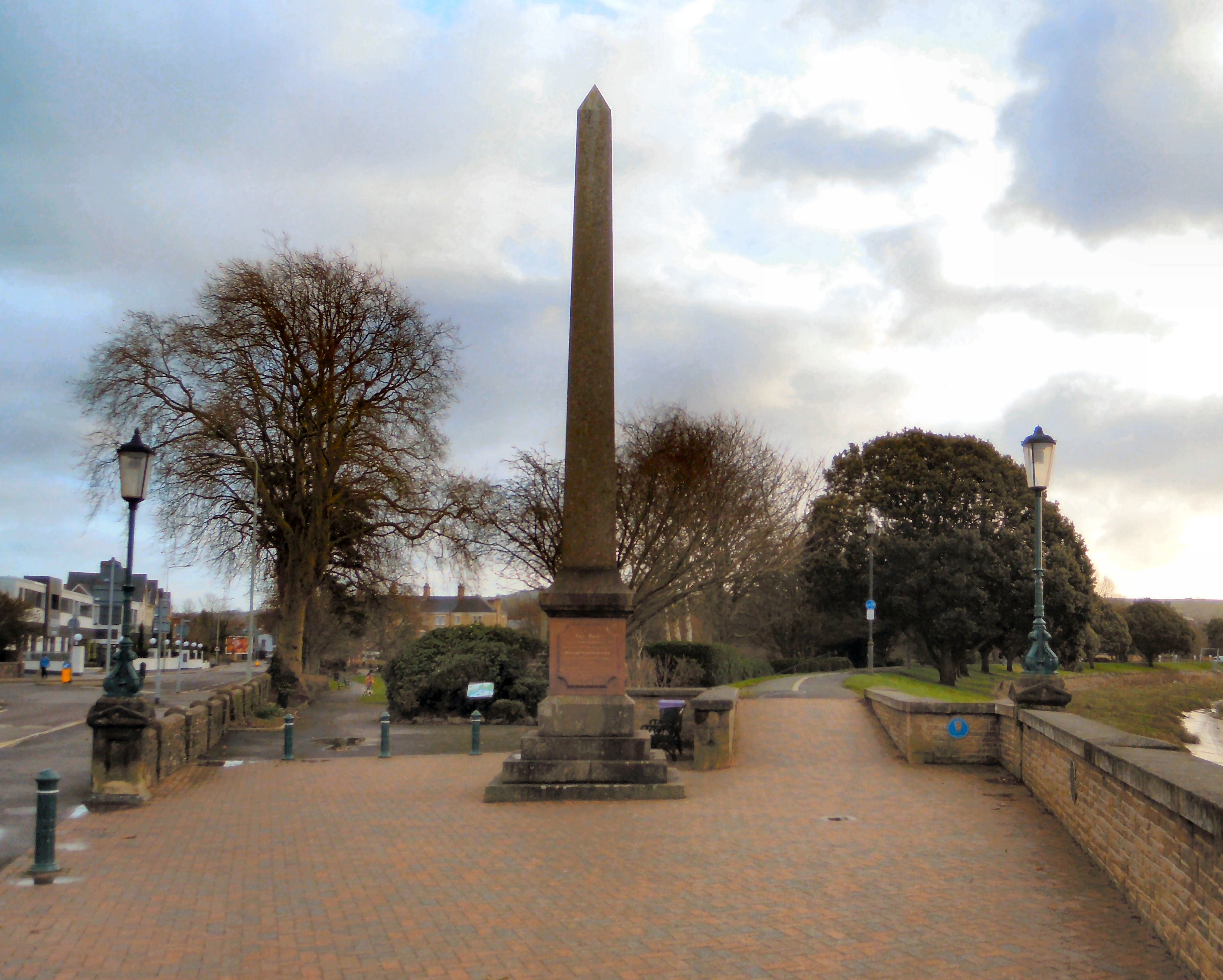|
Rock Park
Rock Park is an urban park in Barnstaple, Devon, England. The park was donated to the public by William Frederick Rock and opened in 1879. It has a number of listed structures including an obelisk at the entrance to the park, a lodge and a range of historic lamp posts. History The park was donated to the public by William Frederick Rock and officially opened 12 August 1879. It was designed and laid out by RD Gould. The opening was commemorated with an obelisk at the entrance to the park which is a listed structure with Historic England. William Rock was born in Barnstaple and educated at Christ's Hospital London, he started a successful printing business and became wealthy. He became a benefactor to the town founding the literary and scientific foundation in 1845, Rock Park in 1879 and North Devon Athenæum in 1888. Landmarks The park contains a number of structures listed with Historic England. These include Rock Park Lodge which was built in Queen Anne style. There are a num ... [...More Info...] [...Related Items...] OR: [Wikipedia] [Google] [Baidu] |
Urban Park
An urban park or metropolitan park, also known as a city park, municipal park (North America), public park, public open space, or municipal gardens (United Kingdom, UK), is a park or botanical garden in cities, densely populated suburbia and other municipal corporation, incorporated places that offers open space reserve, green space and places for recreation to residents and visitors. Urban parks are generally Landscape architecture, landscaped by design, instead of lands left in their natural state. The design, operation and maintenance, repair and operations, maintenance is usually done by government agencies, typically on the local government, local level, but may occasionally be contracted out to a park conservancy, "friends of" group, or private sector company. Depending on size, budget, and land features, which varies considerably among individual parks, common features include playgrounds, gardens, hiking, running, fitness trails or paths, bridle paths, sports fields and c ... [...More Info...] [...Related Items...] OR: [Wikipedia] [Google] [Baidu] |
Barnstaple
Barnstaple ( or ) is a river-port town and civil parish in the North Devon district of Devon, England. The town lies at the River Taw's lowest crossing point before the Bristol Channel. From the 14th century, it was licensed to export wool from which it earned great wealth. Later it imported Irish wool, but its harbour silted up and other trades developed such as shipbuilding, foundries and sawmills. A Victorian market building survives, with a high glass and timber roof on iron columns. Toponymy The name is first recorded in the 10th century and is thought to derive from the Early English ''bearde'', meaning "battle-axe", and ''stapol'', meaning "pillar", i.e. a post or pillar to mark a religious or administrative meeting place. The derivation from ''staple'' meaning "market", indicating a market from its foundation, is likely to be incorrect, as the use of ''staple'' in that sense first appears in 1423. Barnstaple was formerly referred to as "Barum", as a contraction of the L ... [...More Info...] [...Related Items...] OR: [Wikipedia] [Google] [Baidu] |
Urban Park
An urban park or metropolitan park, also known as a city park, municipal park (North America), public park, public open space, or municipal gardens (United Kingdom, UK), is a park or botanical garden in cities, densely populated suburbia and other municipal corporation, incorporated places that offers open space reserve, green space and places for recreation to residents and visitors. Urban parks are generally Landscape architecture, landscaped by design, instead of lands left in their natural state. The design, operation and maintenance, repair and operations, maintenance is usually done by government agencies, typically on the local government, local level, but may occasionally be contracted out to a park conservancy, "friends of" group, or private sector company. Depending on size, budget, and land features, which varies considerably among individual parks, common features include playgrounds, gardens, hiking, running, fitness trails or paths, bridle paths, sports fields and c ... [...More Info...] [...Related Items...] OR: [Wikipedia] [Google] [Baidu] |
William Frederick Rock
William Frederick Rock (29 January 1801 – 8 February 1890) was a British publisher and philanthropist. Early life Rock was born in Barnstaple to Henry and Prudence Rock. William was an elder child and older brother; he had two sisters, Ann (born 1804), Prudence (born 1810) and two brothers, Henry (born 1806) and Richard (born 1808). Another brother Charles and a sister Maria died as babies. His father was a shoemaker at 46 High Street and a freeman of the borough holding a right to vote. William came into contact with William Busk, a parliamentary contestant, who visited with the family. Busk took an interest in William and was able to present him to Christ's Hospital's London Bluecoat School, where he started in 1811. Career On leaving school, Rock joined a bank in Bideford, but the job apparently did not suit him as he ran into trouble several times for composing verses at work. Rock resigned and went to London, where another ex-parliamentary candidate for Barnstaple, Ald ... [...More Info...] [...Related Items...] OR: [Wikipedia] [Google] [Baidu] |
Historic England
Historic England (officially the Historic Buildings and Monuments Commission for England) is an executive non-departmental public body of the British Government sponsored by the Department for Culture, Media and Sport. It is tasked with protecting the historic environment of England by preserving and listing historic buildings, scheduling ancient monuments, registering historic parks and gardens, advising central and local government, and promoting the public's enjoyment of, and advancing their knowledge of, ancient monuments and historic buildings. History The body was created by the National Heritage Act 1983, and operated from April 1984 to April 2015 under the name of English Heritage. In 2015, following the changes to English Heritage's structure that moved the protection of the National Heritage Collection into the voluntary sector in the English Heritage Trust, the body that remained was rebranded as Historic England. The body also inherited the Historic Engla ... [...More Info...] [...Related Items...] OR: [Wikipedia] [Google] [Baidu] |
North Devon Athenæum
Museum of Barnstaple and North Devon is a local museum covering the history and culture of the North Devon area and which is located in The Square in Barnstaple in Devon. The displays range from prehistoric times to the Victorian era. The building and its garden railings beside the river front have been Grade II listed since 1988. Design The structure was built in 1872 for William Thorne, but sold to the Barnstaple Bridge Trust in 1876 who then sold it to William Frederick Rock. Constructed in red brick with dressings of stone and terracotta, the hipped and slated roof has a flat central section which is set with ornamental iron railings together with 5 red brick chimneys with stone caps. The building is square and is built round an internal courtyard with on the right on the building's North side a small service wing which may actually be a former coach-house with a walled courtyard behind. Inside is a fine wooden staircase in the Jacobean style with twisted balusters and l ... [...More Info...] [...Related Items...] OR: [Wikipedia] [Google] [Baidu] |
British Queen Anne Revival
British Queen Anne Revival architecture, also known as Domestic Revival, is a style of building using red brick, white woodwork, and an eclectic mixture of decorative features, that became popular in the 1870s, both for houses and for larger buildings such as offices, hotels, and town halls. It was popularised by Norman Shaw (1831–1912) and George Devey (1820–1886). Beginnings The Queen Anne Revival was to a large extent anticipated by George Frederick Bodley, George Gilbert Scott, Norman Shaw, W. Eden Nesfield, J. J. Stevenson, and Philip Webb in the 1860s; they had used and mixed together brick pediments and pilasters, fan-lights, ribbed chimneys, Flemish or plain gables, hipped roofs, wrought-iron railings, sash windows, outside shutters, asymmetry and even sunflower decorations. Features The Queen Anne Revival style has, as the architectural historian Mark Girouard writes, All of these features can be seen in houses, large or small, of the later part of ... [...More Info...] [...Related Items...] OR: [Wikipedia] [Google] [Baidu] |
River Taw
The River Taw () in England rises at Taw Head, a spring on the central northern flanks of Dartmoor, crosses North Devon and at the town of Barnstaple, formerly a significant port, empties into Barnstaple Bay in the Bristol Channel, having formed a large estuary of wide meanders which at its western end is the estuary of the River Torridge. Course As a stream, the Taw heads north and gives its name to the villages of South Tawton and North Tawton. Headwaters add to the size from a number of two major upper course tributaries including the River Yeo (Lapford), Lapford Yeo and Little Dart River. Along the middle course the Taw receives the River Mole, Devon, River Mole (distributary of the River Bray and a second Yeo), which all rise on upland Exmoor to the north-east. By this midway stage the river has increased in size and becomes a season-round recreational trout, sea trout and salmon river before becoming tidal at ''Newbridge'', approximately from the sea. The river drains ... [...More Info...] [...Related Items...] OR: [Wikipedia] [Google] [Baidu] |
Parkrun
Parkrun (stylised as parkrun) is a collection of 5K run, events for runners, walkers and volunteers that take place every Saturday morning at more than 2,000 locations in 23 countries across five continents. Parkrun was founded by Paul Sinton-Hewitt on 2 October 2004 at Bushy Park in London, England. The event was originally called the Bushy Parkrun, Bushy Park Time Trial. It grew into a network of similar events called the UK Time Trials, before adopting the name Parkrun in 2008 and expanding into other countries. The first event outside the United Kingdom was launched in Zimbabwe in 2008, followed by Denmark in 2009, South Africa and Australia in 2011 and the United States in 2012. Sinton-Hewitt was appointed CBE for his services to grassroots sport in 2014. By October 2018 over 5 million runners were registered worldwide, now over 10 million. Events take place at a range of general locations including parks, stately homes, forests, rivers, lakes, reservoirs, beaches, prome ... [...More Info...] [...Related Items...] OR: [Wikipedia] [Google] [Baidu] |
Parks And Open Spaces In Devon
A park is an area of natural, semi-natural or planted space set aside for human enjoyment and recreation or for the protection of wildlife or natural habitats. Urban parks are green spaces set aside for recreation inside towns and cities. National parks and country parks are green spaces used for recreation in the countryside. State parks and provincial parks are administered by sub-national government states and agencies. Parks may consist of grassy areas, rocks, soil and trees, but may also contain buildings and other artifacts such as monuments, fountains or playground structures. Many parks have fields for playing sports such as baseball and football, and paved areas for games such as basketball. Many parks have trails for walking, biking and other activities. Some parks are built adjacent to bodies of water or watercourses and may comprise a beach or boat dock area. Urban parks often have benches for sitting and may contain picnic tables and barbecue grills. The largest ... [...More Info...] [...Related Items...] OR: [Wikipedia] [Google] [Baidu] |






